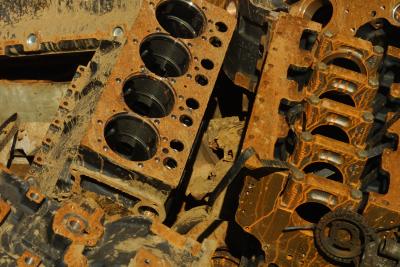
The average engine uses two basic kinds of split-shell bearings: the rod bearings that sit between the connecting rod and the rod journal on the crankshaft and the bearings that sit between the main bearing journals and the engine block. Under- and oversized bearings are two tools that engine builders use to bring everything back into spec after a major rebuild and machine work.
A completed bearing is like a ring; it has an outside diameter and an inside diameter. The outside diameter of the bearing is what fits into the engine block, and the crankshaft rests on the inside diameter. An oversized bearing has the same inside diameter but a bit more material on the outside diameter. An undersized bearing measures the same outside but is thicker on the inside. For instance, if a completed bearing measures 3 inches on the outside diameter and has a stock metal thickness of 0.20-inch, then its inside diameter will measure 2.40-inch. Add 0.10-inch of thickness to the inside to create an undersized bearing and you've still got 3 inches on the outside but 2.30 inches on the inside.
An oversized bearing is one that fits into a larger hole in the engine block, into the hole created by bolting the main caps to the engine block. You may be wondering how exactly this hole would get bigger in the first place; after all, the bearing normally wouldn't spin against the block, so there's no reason for the outer bearing or block to wear. Bearings can and do spin in the block sometimes, but more often than not, oversized bearings find use in blocks that have been line-bored. This procedure involves bolting the mains to the block and running a big cylindrical cutter through all of them. This gets all of the mean bearings into perfect alignment, increasing bearing life and decreasing vibration and stress on the crank. Oversized bearings compensate for the amount of material removed during the machining process.
As you might expect, undersized bearings see use for the exact opposite reason that oversized bearings do. While line-boring a block isn't usually necessary unless the engine's spun a bearing or the builder wishes to assemble a perfect creation, crankshaft machining is much more common. Crankshaft journals bear the brunt of your engine's horsepower assault and are subject to all sorts of damage and wear. Journal scoring or scratching as a result of oil contamination is common. To restore the journals to stock smoothness, machinists remove just enough material from the journal surface to eliminate the deepest scratches. Undersized bearings compensate for the amount of material removed during this machining process.
Bearings don't have to be just oversized or just undersized; many antique engine builders will both line-bore the block and machine the crankshaft to make use of more modern bearings designed for a completely different engine. For instance, say you have an old Bentley engine and you want to get it running, but no one makes parts for it. If the engine's main bearing bores measure 2.650 and the crank journals measure 2.450, you could have the main bores machined to 2.64 and the crank to 2.45; that would allow you to utilize the cheap and readily available small-block Chevy main bearing for initial assembly and any future rebuilds.